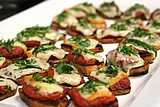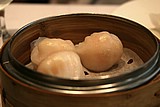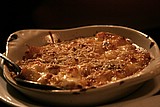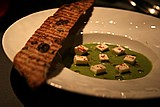Home |
Restaurants by City
|
Food Photography |
Archive | Philosophy |
![]()
Right now we are eating in Seattle, Washington.
|
Wednesday
2006
Permalink
|
A Week at the Culinary Institute of America (continued) - Finished Dishes, Hyde Park, NY, tasted on December 19-22, 2005 — In the last post we covered the actual cooking of the food. At the ends of day two and four we gathered all our creations and laid them out on a table in the hallway outside our kitchen - cruise ship buffet style minus the ice sculptures. And as much as we learned during the hands on portions of the class, the time in the kitchen was at its most useful in giving a sense of what it's really like to work with professional equipment, in a true commercial kitchen. And frankly the experience is exciting and fun. Unfortunately the food we made, well, to be honest, for the most part wasn't that good. I'm sure that part of it was our lack of skill. But part of it is also about, as discussed earlier, scale. We were cooking lots of dishes for lots of eaters (us mainly). In fact we ended up wasting a lot of food which was kind of a bummer even after all the hungry people sampled our cooking. There were a few dishes that came out decently, but in terms of quality of flavor, texture, and temperature at the time the food was served our dishes were American hotel buffet quality... and not some of the better buffets either. This fact didn't take away from my satisfaction with the educational experience. In fact it made me appreciate even more how hard it is not just to make food for lots of people with high expectations in a timely fashion, nonetheless make that food really high quality. It's unbelievably difficult. And while learning the key lessons of how to cook at scale don't guarantee you'll make great food at scale, you can't get to great food and commercial success without being grounded in those same lessons. The dishes we made included: Cheese Sticks, Palmiers with Prosciutto, Smoked Trout Canapés, Pickled Shrimp, Bruschetta with Oven Roasted Tomatoes and Fontina Cheese, Veggie Sushi, Crispy Scallion Pancakes with Dipping Sauce, Grapes Rolled in Bleu de Bresse, Smoked Whiskey Shrimp, Smoked Breast of Duck Niçoise Style, Mushroom Terrine, Mozzarella, Prosciutto, and Roasted Tomato Terrine, Wontons, Seafood Sausage, Grilled Honey-Smoked Quail with Mango Sauce, Crab Meat Rolls with Infused Pepper Oils, Fried Ginger, and Tamari-Glazed Mushrooms with Vietnamese Dipping Sauce, Roasted Pepper and Eggplant Terrine, Chicken Breast Roulade with Marinated Tomatoes and Papaya Catsup, Smoked Duck and Malfatti Salad with Roasted Shallot Vinaigrette, Gravlax with Potato Galette, and Tuna Carpaccio with Shiitake Salad to name a few. After serving and sampling our creations we would gather round single plated versions we'd done and critique our creations. I often felt that we were more hardcore than Chef D was in terms of judging what we'd made. That said, I imagine that most of the people who take this class aren't looking to get their ass kicked and told they sucked. Strangely enough that's exactly what we were looking for. I don't know if this is some masochistic tendency but basically we were eager to get pushed to do better.
|
|||
Our Sponsors
Free Car Listings – Hot Tubs – Stools – Saunas – Bar Stools - Calendar and Event Schedules - Food Events and Calendars - Wine Events and Calendars - Digital Photography Resources - Software for Advertisers - Jewish Gifts and Judaica - Howard Stern Podcast - ponytailed blogger Jonathan Schwartz

Browse tastingmenu
Home |
Restaurants by City X |
Food Photography |
Archive | Philosophy |
![]()
Free eBooks: All About Apples
| Autumn Omakase
More:
Discussion |
Cool Food T-Shirts |
Ingredients
| Markets |
Recipes
Search |
Blog FAQ |
Other
Blogs
Best of tastingmenu
|
City View
Entry: July 6, 2006 |
Blue Plate
Entry: June 19, 2006 |
L'Atelier de Joël Robuchon
Entry: July 18, 2006 |
Browse by City
Boston | Chicago | Houston | Las Vegas | Los Angeles | Maui | New York | Philadelphia | Portland | San Francisco | Seattle | Toronto | Utah | Vancouver | Washington D.C.
Bangkok | Beijing | Hong Kong | Seoul | Tokyo
Amsterdam | Berlin | Italy | London | Madrid | Paris | Vienna
Browse by Month
2006
2005
2004
2003
2002
2001
Comments, questions, or feedback:
info / at / tastingmenu / dot / com
All pages Copyright (c) 2001-2006 tastingmenu.com
Last modified 01/30/07.





